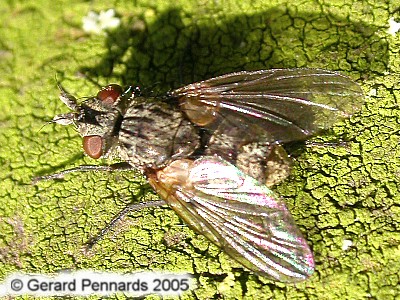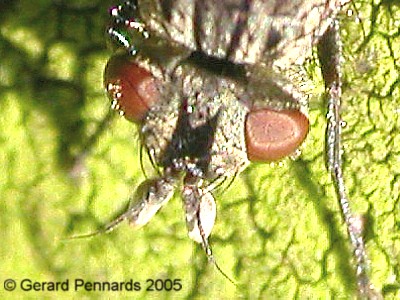Thread subject: Diptera.info :: Muscidae or Tachinidae?
#1
Dear all,
THis one I found near Amsterdam in the Netherlands, it was about 5 mm in lenght.
It was sitting on a tree trunk, basking in the sun.
I first thought it was a kind of Muscidae, but I am not sure anymore!
The specimen seems to have a Tachinid like wing venation, and a very broad frons.
Can somebody give me a clue?
Thanks in advance,
Greetings,
Gerard

#2
Could it be Pollenia spec. (Calliphoridae)?
Posted by
Zeegers on 10-04-2005 20:06
#3
Hoi Gerard,
Definitely a Tachinid.
Difficult to determine based on the picture.
Given the circumstances: early spring on tree stems an educated guess would be:
Campylochaeta praecox.
This species is easily recognized by the ocellar bristles (the strongest bristles between the ocelli) being reclinate (= curved backwards). In nearly all Tachinidae they are proclinate.
So, let me know.
Theo Zeegers
#4
Thanks, Laurens and Theo.
I thought about Pollenia myself, but after I while a realised that Pollenia looks different, and then I started thinking about Tachinidae.
Unfortunately I didn't catch it, it escaped after I made the picture.
Maybe I will see another one the coming days, then I will try to catch one!
So for now I will keep up with the name Theo provided!
Greetings
#5
And a more detailed picture of the head.
Does it help?
Greetings

Posted by
Zeegers on 18-04-2005 20:02
#6
The ocellar bristles appear to be proclinate, so much for Campylochaeta !
My last guess (I know, three is a charm, I'm just trying to keep the level just a little bit of scientific hear): it might be Cyzenis albicans.
Features: tibia reddish.
On the frons: parafrontals (the lateral stripes between ocelli and antennal base) with 1 pair of strong proclinate setae (in both sexes !)
This lack of sexual dimorfism is quite special in Tachinidae: in 90 % of the species the females have 2 pairs of proclinate setae on the parafrontals, whereas males have none.
Otherwise, I pass.
Theo Zeegers

